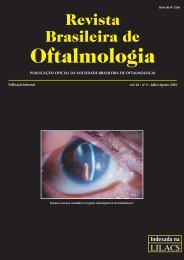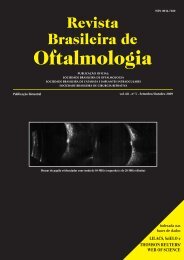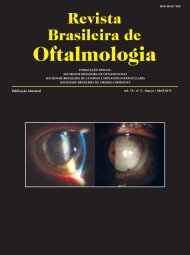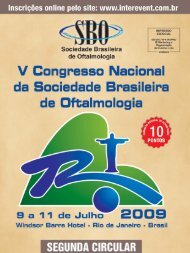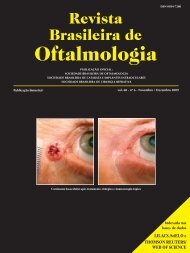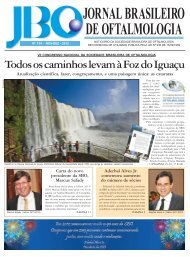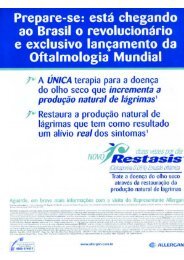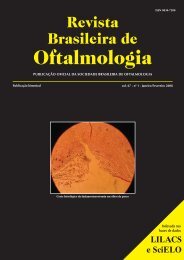ARTIGO ORIGINAL87Reflexões sobre a ceratite fúngica por meio dosachados <strong>de</strong> exames histopatológicosReflections on mycotic keratitis based on findingsfrom histopathologically examined specimensFernando Queiroz Monte 1 , Niedja Marques Stadtherr 2RESUMOObjetivo: Estudo <strong>de</strong> botões corneanos por meio do exame histopatológico para verificar as alterações ocorri<strong>da</strong>s nos tecidos corneanosnuma infecção fúngica e tirar <strong>de</strong>sses achados orientações para o diagnóstico e o tratamento. Métodos: Trabalho retrospectivo,realizado num Banco <strong>de</strong> Olhos (BOO) entre janeiro <strong>de</strong> 2006 e junho <strong>de</strong> 2011, usando <strong>da</strong>dos <strong>de</strong> prontuários a partir <strong>da</strong>s informaçõesenvia<strong>da</strong>s pelos cirurgiões e sendo examinado material recebido <strong>de</strong> ceratoplastia penetrante com o exame <strong>de</strong> 38 peças <strong>de</strong> 35 pacientes,sendo processa<strong>da</strong>s e feitas <strong>de</strong> uma a três colorações <strong>de</strong> acordo com as dificul<strong>da</strong><strong>de</strong>s diagnósticas. Resultados: Os pacientes eramna maioria homens, 57% (n=35), a faixa etária acima <strong>de</strong> 60 anos a mais numerosa com 1/3 dos pacientes. Os casos <strong>de</strong> ceratite fúngicacorrespondiam à média <strong>de</strong> 6,4% (n=597) do material recebido no BOO e 1,65% (n=2310) dos transplantes ocorrido com o materialfornecido nos últimos 5 anos. Pelas informações dos cirurgiões 39,5% (n=38) dos casos <strong>de</strong>viam-se a perfuração corneana. Usando as<strong>da</strong>tas dos transplantes foi feita uma Tábua <strong>de</strong> Observação. Em 11 (n=38) casos, a córnea procedia <strong>de</strong> transplante anterior. As formasleveduriformes nos tecidos corneanos eram <strong>de</strong> 63% (n=38). Em 50% (n=38) dos casos o infiltrado inflamatório era pequeno ouinexistente. A cama<strong>da</strong> <strong>de</strong> Desc<strong>em</strong>et estava íntegra <strong>em</strong> 13% (n=38), enquanto eram encontrados fungos na superfície corneana <strong>de</strong>45% (n=38) dos casos. Conclusão: A coleta do material po<strong>de</strong>rá ser feita com sucesso mesmo <strong>de</strong>pois <strong>de</strong> instalado o tratamento,entretanto, nas úlceras <strong>de</strong> córnea <strong>de</strong>ve ser feito preferent<strong>em</strong>ente a coleta <strong>de</strong> material com espátula para exame laboratorial e amicroscopia confocal in vivo. A predominância <strong>da</strong>s leveduras po<strong>de</strong>rá ser <strong>de</strong>vido a alterações morfológicas do fungo sofri<strong>da</strong>s notecido corneano. A penetração intraocular é facilita<strong>da</strong> por alterações <strong>da</strong> Cama<strong>da</strong> <strong>de</strong> Desc<strong>em</strong>et e pela própria capaci<strong>da</strong><strong>de</strong> do fungo<strong>de</strong> penetrar nos tecidos justificando o tratamento sistêmico <strong>de</strong>s<strong>de</strong> o início.Descritores: Ceratite/diagnóstico; Ceratite/patologia; Infecções oculares fúngicas/diagnósticoABSTRACTPurpose: The study of fungal invasion and pathogenicity in corneal tissue observed through the histopathological examination ofspecimens obtained through penetrating keratoplasty (‘PKP’) of samples obtained from an Eye Bank (‘EB’), with the aim of applyingfindings in diagnosis and treatment of the condition Methods: Retrospective non-comparative case studies on samples collected betweenJanuary 2006 and June 2011 based on i<strong>de</strong>ntification <strong>da</strong>ta comprised of scant historical information sent by surgeons and materialobtained through PKP, consisting of 38 samples from 35 patients. Processing involved special stains for fungi in or<strong>de</strong>r to <strong>de</strong>tect thepresence thereof, with one to three colourations being performed in accor<strong>da</strong>nce with diagnostic difficulty in relation to each sample.Results: Patients were predominantly male (20 compared to 15 f<strong>em</strong>ales), and the most represented age group was 60+ years of age (1/3 of the patients). Mycotic keratitis was <strong>de</strong>tected in 6.4% (n= 597) of cases referred to the EB and in 1.65% (n= 2310) of transplantsusing corneal material provi<strong>de</strong>d by the EB over the last five years. According to historical information provi<strong>de</strong>d by surgeons, 39.5%(n= 38) of cases were due to perforation of the cornea. A statistical table was prepared using transplant <strong>da</strong>ta. 11 specimens (n= 38) weredue to an anterior corneal graft. Yeasts were present in 63% (n= 38), and 50% (n= 38) of corneal tissue had mild or non-existinginflammation. 13% (n= 38) had whole Desc<strong>em</strong>et layers, while 45% (n= 38) presented fungi on the corneal surface. Conclusion: Cornealgrasping and confocal microscopy may be performed successfully after treatment has been initiated, although in corneal ulcers samplesshould i<strong>de</strong>ally be collected with a spatula for laboratory testing in vivo. The high prevalence of yeasts in the samples we looked at may bedue to morphologic changes in corneal tissue of fungal origin. Intraocular penetration of the fungi is facilitated by changes to theDesc<strong>em</strong>et layer, and assisted by the fungi’s own properties. Therefore syst<strong>em</strong>ic treatment is justified from the outset.Keywords: Keratitis/diagnosis, Keratitis/pathology; Eye infections, fungal/diagnosis1Banco <strong>de</strong> Olhos <strong>da</strong> Secretaria <strong>de</strong> Saú<strong>de</strong> do Estado do Ceará – Fortaleza (CE), Brasil;2Serviço <strong>de</strong> Oftalmologia do Hospital Geral do Exército - Fortaleza (CE), Brasil.Trabalho realizado no Banco <strong>de</strong> Olhos <strong>da</strong> Secretaria <strong>de</strong> Saú<strong>de</strong> do Estado do CearáHospital Geral <strong>de</strong> Fortaleza - Fortaleza (CE), Brasil. Vencedor, na Categoria Master, do 40° Prêmio Varilux <strong>de</strong> OftalmologiaOs autores <strong>de</strong>claram não haver conflitos <strong>de</strong> interesseRecebido para publicação <strong>em</strong>: 9/4/2012 - Aceito para publicação <strong>em</strong>: 29/5/2012Rev Bras Oftalmol. 2013; 72 (2): 87-94
88Monte FQ, Stadtherr NMINTRODUÇÃOAceratite micótica tinha características pouco atraentespara os centros <strong>de</strong> pesquisas porque além <strong>de</strong> ser maisfrequentes nas regiões <strong>de</strong> clima quente, composta <strong>de</strong>países que <strong>de</strong>spend<strong>em</strong> pouco recurso <strong>em</strong> pesquisa. Por outro lado,acometia populações rurais que vêm <strong>de</strong>crescendo nos últimosséculos <strong>de</strong>vido à urbanização inicia<strong>da</strong> após a revolução industrial.Entretanto a sua <strong>de</strong>finição foi feita num país <strong>de</strong> clima t<strong>em</strong>perado,on<strong>de</strong> os casos são raros. Foi <strong>de</strong>scrita pela primeira vez porLeber, <strong>em</strong> 1879, um camponês, <strong>de</strong> 54 anos, que trabalhando numamáquina trituradora (Dreschmaschine) recebeu um leve traumana córnea por um fragmento <strong>de</strong> aveia (haferspelze) (1) . Já <strong>em</strong>1907, Za<strong>de</strong> apresentou o caso <strong>de</strong> uma camponesa <strong>de</strong> 44 anos eao fazer o levantamento na literatura, encontrou 22 casos <strong>de</strong>ceratite micótica. Anexo ao texto apresentou o <strong>de</strong>senho <strong>da</strong> formaencontra<strong>da</strong> no laboratório, mostrando o aspecto <strong>de</strong>Aspergillus (2) .Na segun<strong>da</strong> meta<strong>de</strong> do século XX houve um aumentocrescente no número <strong>de</strong> casos, sobretudo pela generalização douso <strong>de</strong> antibióticos e corticosterói<strong>de</strong>s tópicos e ao aumento donúmero <strong>de</strong> transplantes e <strong>de</strong> pacientes imuno<strong>de</strong>primidos, o quefez nascer um relativo interesse, pois passou a acometer pessoas<strong>da</strong>s áreas urbanas.Poucos foram os artigos publicados <strong>em</strong> que se estu<strong>da</strong>va ahistopatologia <strong>da</strong> córnea nas infecções fúngicas. O artigo maisamplo que tiv<strong>em</strong>os acesso foi o <strong>de</strong> Naumann et al. (3) os quaisapresentaram casos recebidos pelo Armed Forces Laboratory ofOcular Pathology, que recebeu casos do sul dos Estados Unidos<strong>da</strong> America e <strong>de</strong> países <strong>da</strong> África e América do Sul. Antes,Zimmerman, usando a mesma amostra, havia mostrado imagens<strong>de</strong> tecido corneano <strong>de</strong> 7 casos (4) .Existe uma explicação prática para o pouco interesse <strong>da</strong>histopatologia para esses casos, acrescenta<strong>da</strong> as que colocamosacima, é <strong>de</strong> que através <strong>de</strong>la não se po<strong>de</strong>rá chegar ao diagnósticoetiológico que t<strong>em</strong> um interesse mais direto para o tratamento,segundo o pensamento ontogênico predominante na medicina.Entretanto, ao dispor <strong>de</strong> uma quanti<strong>da</strong><strong>de</strong> satisfatória <strong>de</strong> casos,resolv<strong>em</strong>os tirar proveito dos achados para refletir sobre adoença e oferecer sugestões que sirvam para minimizar os efeitos<strong>da</strong>nosos <strong>de</strong>la. Fomos movidos pela curiosi<strong>da</strong><strong>de</strong> sobre o quepassa no tecido corneano nessa infecção. Os casos examinadosnão tinham nenhum resultado <strong>de</strong> exame microbiológico e parcasinformações o que nos permitiu explorar ao máximo o que sevisualizava nas lâminas e procuramos tirar as lições que pu<strong>de</strong>ss<strong>em</strong>ter um interesse prático.MÉTODOSEstudo realizado no Banco <strong>de</strong> Olhos <strong>da</strong> Secretaria <strong>de</strong> Saú<strong>de</strong>do Estado do Ceará, que, para controlar melhor os casos <strong>de</strong>urgência, exigiu que foss<strong>em</strong> envia<strong>da</strong>s as córneas dos receptorespara que pu<strong>de</strong>ss<strong>em</strong> ser submeti<strong>da</strong>s a exame histopatológico. Oscasos que não foss<strong>em</strong> <strong>de</strong> urgência po<strong>de</strong>riam ter o material examinadose o cirurgião <strong>de</strong>sejasse obter algum esclarecimento sobreeles.O material enviado vinha apenas com o formulário padrãopreenchido com <strong>da</strong>dos sumários sobre o caso, não havendo informaçõesadicionais. Não havia história clínica <strong>de</strong>talha<strong>da</strong> dos sinaisclínicos somente os que po<strong>de</strong>riam servir como justificativa, mass<strong>em</strong> <strong>da</strong>dos cronológicos <strong>da</strong> evolução <strong>da</strong> enfermi<strong>da</strong><strong>de</strong>.O material recebido era encaminhado para o Laboratório<strong>de</strong> Anatomia Patológica do Hospital Geral <strong>de</strong> Fortaleza on<strong>de</strong> oBanco <strong>de</strong> Olhos é sediado. O exame macroscópico dos botõescorneanos foi realizado pelo patologista do Banco <strong>de</strong> Olhosque, <strong>de</strong>pois <strong>de</strong> <strong>de</strong>screvê-lo recortava o material e colocava paraser incluído <strong>de</strong> forma que pu<strong>de</strong>ss<strong>em</strong> ser examina<strong>da</strong>s to<strong>da</strong>s ascama<strong>da</strong>s <strong>da</strong> córnea. A inclusão foi feita <strong>em</strong> parafina, <strong>de</strong>pois <strong>da</strong>qual o material foi cortado com espessura <strong>de</strong> 5µ. Todo materialfoi corado por H<strong>em</strong>atoxilina-eosina, nos casos <strong>em</strong> que haviadúvi<strong>da</strong> <strong>de</strong> consoli<strong>da</strong>ção do diagnóstico <strong>de</strong> ceratite fúngica foramrealiza<strong>da</strong>s as colorações <strong>de</strong> PAS (Periodic Acid of Schiff reaction),<strong>de</strong> Prata metanamina, na reação <strong>de</strong> Gomori, e a coloração <strong>de</strong>Masson. Na maioria dos casos não houve dificul<strong>da</strong><strong>de</strong>s para odiagnóstico com a coloração <strong>de</strong> rotina (H<strong>em</strong>atoxilina-Eosina) eas poucas dúvi<strong>da</strong>s foram tira<strong>da</strong>s com o auxílio <strong>de</strong> outras colorações.Enfim, a H<strong>em</strong>atoxilina-Eosina foi utiliza<strong>da</strong> isola<strong>da</strong>mente<strong>em</strong> 30 casos (79%), associa<strong>da</strong> à Prata metanamina, <strong>em</strong> 3 casos(7,9%); as duas colorações acrescenta<strong>da</strong> o PAS foram realiza<strong>da</strong>s<strong>em</strong> 4 (10.5%) casos; e a tripla associação, com a substituição doPAS pelo Masson, <strong>em</strong> 1 (2,6%) caso.O levantamento teve início <strong>em</strong> janeiro <strong>de</strong> 2006 e foi concluído<strong>em</strong> junho <strong>de</strong> 2011. Foram examinados retrospectivamente,597 casos <strong>de</strong> um total 2310 transplantes realizados no período,dos quais 38 exames tiveram o diagnóstico histopatológico <strong>de</strong>ceratite fúngica.No protocolo <strong>da</strong> pesquisa foram obtidos os <strong>da</strong>dos do prontuáriodo paciente <strong>em</strong> que eram colhi<strong>da</strong>s as informações do cirurgiãosobre o transplante constante na solicitação <strong>da</strong> córneapara a cirurgia.Para o preenchimento <strong>de</strong> <strong>da</strong>dos <strong>da</strong>s lâminas foram consi<strong>de</strong>radosos seguintes <strong>da</strong>dos: colorações usa<strong>da</strong>s, morfologia dosfungos, aspecto geral <strong>da</strong> córnea, localização do parasita, aspecto<strong>da</strong> cama<strong>da</strong> <strong>de</strong> Desc<strong>em</strong>et e <strong>de</strong>scrição <strong>de</strong> infiltrado inflamatóriona córnea. Os <strong>da</strong>dos foram tabulados, para apresentação dosresultados.RESULTADOSA composição <strong>da</strong> amostra quanto ao gênero foi <strong>de</strong> 20 homense 15 mulheres acometidos, como houve três casos <strong>de</strong> recidiva,essas ocorreram <strong>em</strong> dois homens e uma mulher.Quanto à faixa etária dos pacientes, observamos que nãohouve casos <strong>da</strong> doença antes dos 20 anos <strong>de</strong> i<strong>da</strong><strong>de</strong> e o mais idosotinha 81 anos. Entre os 20 e 29 anos, houve 3 (8,5%) casos; na <strong>de</strong>30 a 39, 8 (23%) casos; já entre 40-49, foram 6 (17%) casos;enquanto na faixa <strong>de</strong> 50-59, ocorreram 5 (14%) casos; entretantoo maior número <strong>de</strong> casos ocorreu acima <strong>de</strong> 60 anos, queconcentrou 11 (31,5%) casos.Nos <strong>da</strong>dos gerais <strong>da</strong> amostra constam a distribuição anual<strong>de</strong> material vindo <strong>de</strong> botões corneanos obtidos através <strong>de</strong> transplante<strong>em</strong> 35 pacientes on<strong>de</strong> foram diagnosticados 38 casos <strong>de</strong>ceratite fúngica, nos cinco anos e meio <strong>em</strong> que foram enviados.Na tabela 1 estão expostos os casos <strong>de</strong> ceratite fúngica paraca<strong>da</strong> ano, compara<strong>da</strong> ao número <strong>de</strong> córneas envia<strong>da</strong>s ao Banco<strong>de</strong> Olhos para a comprovação <strong>da</strong> urgência do caso sendo <strong>de</strong>termina<strong>da</strong>a taxa <strong>de</strong> frequência <strong>da</strong> doença naquela amostra; constam,ain<strong>da</strong>, o número <strong>de</strong> transplantes realizados no período comcórneas forneci<strong>da</strong>s pelo Banco <strong>de</strong> Olhos e a taxa anual para aceratite fúngica.As informações ofereci<strong>da</strong>s pelos cirurgiões, para justificara priori<strong>da</strong><strong>de</strong> dos transplantes propostos, estão alinha<strong>da</strong>s na tabela2.Houve um gran<strong>de</strong> número <strong>de</strong> casos <strong>de</strong> ceratites fúngicasque pud<strong>em</strong>os acompanhar a sua evolução do quadro sob o as-Rev Bras Oftalmol. 2013; 72 (2): 87-94
- Page 1 and 2: Versão impressavol. 72 - nº 2 - M
- Page 3 and 4: 80Revista Brasileira de Oftalmologi
- Page 5 and 6: 82108 Efeitos de algumas drogas sob
- Page 7 and 8: 84Kara-Junior Ninúmeras vezes ante
- Page 9: 86Ambrósio Júnior Raplicação de
- Page 13 and 14: 90Monte FQ, Stadtherr NMFigura 1AFi
- Page 15 and 16: 92Monte FQ, Stadtherr NMtempo (3) .
- Page 17 and 18: 94Monte FQ, Stadtherr NM11. Höffli
- Page 19 and 20: 96Grandinetti AA, Dias J, Trautwein
- Page 21 and 22: 98Grandinetti AA, Dias J, Trautwein
- Page 23 and 24: 100Ambrósio Jr R, Ramos I, Luz A,
- Page 25 and 26: 102Ambrósio Jr R, Ramos I, Luz A,
- Page 27 and 28: 104Caballero JCS, Centurion VINTROD
- Page 29 and 30: 106Caballero JCS, Centurion VDISCUS
- Page 31 and 32: ARTIGO ORIGINALEfeitos de algumas d
- Page 33 and 34: 110Almodin J, Almodin F, Almodin E,
- Page 35 and 36: 112 ARTIGO ORIGINALFluência do las
- Page 37 and 38: 114Lucena AR, Andrade NL, Lucena DR
- Page 39 and 40: 116RELATO DE CASOAsymptomatic ocula
- Page 41 and 42: 118Freitas LGA, Gabriel LAR, Isaac
- Page 43 and 44: 120Ticly FG, Lira RPC, Fulco EAM, V
- Page 45 and 46: 122RELATO DE CASOAssociation of mac
- Page 47 and 48: 124Tavares RLP, Novelli FJ, Nóbreg
- Page 49 and 50: 126Marback EF, Freitas MS, Spínola
- Page 51 and 52: 128RELATO DE CASONeurofibromatose t
- Page 53 and 54: 130Moraes FS, Santos WEM, Salomão
- Page 55 and 56: 132 ARTIGO DE REVISÃOAntifúngicos
- Page 57 and 58: 134Müller GG, Kara-José N, Castro
- Page 59 and 60: 136Müller GG, Kara-José N, Castro
- Page 61 and 62:
138Müller GG, Kara-José N, Castro
- Page 63 and 64:
140Müller GG, Kara-José N, Castro
- Page 65 and 66:
142 ARTIGO DE REVISÃOImportância
- Page 67 and 68:
144Rehder JRCL, Paulino LV, Paulino
- Page 69 and 70:
146Rehder JRCL, Paulino LV, Paulino
- Page 71 and 72:
148Instruções aos autoresA Revist
- Page 73:
150RevistaBrasileira deOftalmologia



